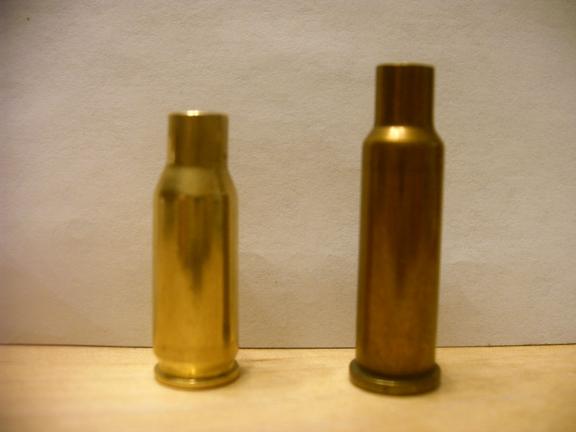From Jed:
Brian, I have a 218 Bee fired case and compared it to the 223 Short they seem to hold the same amount of powder, both of them hold 1 cc up about half way in the neck. I would think you could start with loading data from the Bee as it is a moderate to lower pressure round. Jed
From Jed:
Brian, Shortly after I sent you the pic of the 218 Bee I got to thinking somethings wrong.
A 218 Bee has a much more sloping sholder and does not look like the case in the pic I sent.
I looked at it more carefully and it must be a Ackley Bee or something like that.
The headstamp reads 218 Bee but when I measured it from the top of the rim to the shoulder the Bee is suppose to be .800 this one measures .950 a whopping .150 longer in body length and has a much sharper shoulder than the Bee. Thats why it holds as much powder as the Short, It has been blown out to a wildcat dimension. Sorry if I had you worried. Jed
Here's a pic of the two side by side.

223 Short 218 Ackley Bee
The Bee case is .347 at the base, compared to the 223 .376, the Bee case length is 1.345 compared to the Short 1.125. The Bee case looks huge in comparison.
Well folks, it looks like we appear to have met some major design goals:
1. A modern case design alternative to the 218 Bee and 22 Rem Jet with a 11% increase in case capacity to 1.11cc.
2. The case can be formed easily from inexpensive 223 Rem cases.
3. The knowledge of how 221 FB dies are modified to work with this round.
Also:
We should be able to use 218 Bee load data to begin with.
We will use L'il Gun powder to begin with.
We will use Small Pistol Primers to begin with.
What we don't know yet:
1. What will our maximum cartridge overall length be?
2. What will be the best and maximum bullet weights for the 22 WMR barrel twist rate?
3. Whether or not we can use a centerfire SB1 receiver?
That's all I can think of right now.